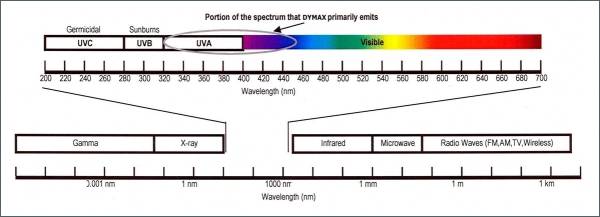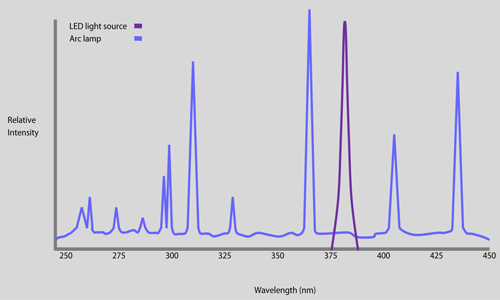关于 UV LED光固化的关键概念
我们中的许多人都不幸长时间暴露在阳光下,导致晒伤和不适。因此,太阳发出的光与UV固化设备产生的能量相差甚远,导致人们表现出焦虑甚至恐惧。对于在工业环境中使用这些系统的操作员以及在沙龙或 DIY 家用套件中使用UV灯固化指甲凝胶和涂层的个人来说,暴露在紫外线下已成为一个问题。
一个常见的误解是光固化UV灯和 LED(发光二极管)灯不同,并且 LED 灯更安全。然而,事实并非如此,因为这两种系统都会发射 320-405 nm 光谱的紫外线。传统的UV灯利用广谱灯泡通过汽化进行固化,而 LED 是一种半导体,当电流通过时会产生光。LED 灯使用发光二极管阵列来产生光固化。
通过正确了解紫外线/可见电磁波谱、不同灯和波长在不同容量中的使用方式以及实施适当的保护协议,操作员可以确定固化灯的最佳用途,以便在使用光固化过程时感到安全和自信。
一切是如何开始的
UV/可见光固化技术已使用 60 多年,具有诸多优势,尤其是对于制造商而言,他们利用它来提高装配速度和产量、降低材料成本并设计出更环保的装配工艺。从历史上看,许多组件、零件和子组件都使用铆钉、螺钉和其他机械紧固件将它们连接在一起。随着光固化胶粘剂和随后的光固化灯的发明,该技术使工程师能够设计出制造方法,从而产生更牢固的粘合,实现更快的装配(几秒钟内),更均匀地分布重量和应力,并能够粘合不同基板,同时实施用户和环境友好的工艺。
随着光固化在制造业中得到广泛接受,该技术从传统的广谱汞弧和卤素灯泡发展到 LED。LED 最初被集成到牙科灯中,用于固化光敏修复材料。如今,它们被用于许多不同的领域,从工业固化应用和家用照明到固化 UV LED 指甲凝胶。
但是这种光能是什么?它来自哪里?了解电磁波谱和不同类型光的基本知识对于理解该技术的工作原理至关重要。
电磁波谱以及 UVA、UVB 和 UVC 紫外线之间的差异
电磁波谱是所有已知频率及其相关波长的统称,这些波长是已知光子(电磁辐射)。电磁波谱是传播速度与光速相当的辐射范围,根据波长可分为不同的区域,从无线电波(~1 米 - 11 公里)、可见光和紫外线(~300-800 纳米)到伽马射线(~0.001 纳米)。这些区域的波长通常以纳米 (nm) 为单位,相当于十亿分之一米或千分之一微米。
并非所有紫外线的波长都是相同的。
紫外线是一种能量形式,占据了 X 射线和可见光之间电磁波谱的一小部分。紫外线自然存在于阳光中,但也存在于许多制造系统中。紫外线范围约为 200-400 纳米,分为三个区域,即 UVA、UVB 和 UVC。UVA 范围通常被认为是三者中最安全的。
图 1. 电磁波谱
以下是不同紫外线波长及其优缺点的概述。
紫外线
- 400-320 nm 长波长
- 通常被认为是最安全的紫外线范围
- 占地球上紫外线辐射的 90-95%
- 常用于聚合UV胶粘剂和荧光检查过程。
紫外线
- 320-280 nm 中波长
- 晒伤和皮肤癌的主要原因
- 占地球上紫外线辐射的 5-10%
- 通常用于固化 UV 油墨和漆,因为 UVB 有助于消除表面粘性。
紫外线
- 280-200 nm 短波长
- 最具破坏性的紫外线无法到达地球,因为大气层会将其过滤掉。
- 存在于焊枪和一些汞灯泡等人造光源中
- 常用于灭菌和杀菌应用
UV 广谱和 LED光固化灯
广谱和 LED 是两种主要利用 UVA 光的固化系统。与传统的广谱弧光灯相比,LED 光源的相对强度差异在于其能量波长非常离散。
第一个UV固化设备使用广谱灯来固化粘合剂和涂层。这些传统的汞弧灯是宽带光源,因为它们发射的光线波长范围很广,包括短波紫外线、长波可见光,甚至更长波的红外线,从而产生多个能量峰值。广谱固化系统利用高压金属卤化物灯泡,产生 300 至 450 nm 范围内的光能,并在固化表面提供 50-1,000 mW/cm2 的 UVA 光。
LED 灯使用表面安装的 LED 阵列来产生固化能量,而不是传统的金属卤化物或汞灯泡。它们是半导体能量源,发射非常离散的光能波长,从而产生单一、狭窄的钟形发射光谱。LED 光源的波长分布可以在紫外线或可见光范围内达到峰值,通常在 365、385 或 405 nm,具体取决于 LED 的选择。
图2. 弧光灯与LED光源的波长分布差异。
从广谱固化转换为 LED 技术的原因有很多,包括无需更换灯泡且使用寿命更长(随着时间的推移节省成本)、无需预热(灯泡可立即使用),并且它们不含汞,如弧光灯泡(使用和处理危害较小)。
使用这两种系统都有其固有的优势,但 UV LED 灯产生的固化温度更低,这可能导致一些操作员认为它们更安全。在某种程度上,LED 灯之所以受欢迎是因为它们可以更快地固化指甲涂层等表面,从而减少紫外线照射到皮肤和指甲上的量。传统的 UV 和 LED 灯可以固化抛光剂和指甲凝胶涂层,并且是固定指甲凝胶和加快常规修甲速度所必需的。在固化指甲凝胶时, UV灯可能需要长达两分钟才能固化涂层,而 LED 灯可以在几秒钟内固化涂层。缩短固化时间是一个明显的优势,因为它限制了手部暴露在紫外线下的时间。
限制紫外线照射
最近,关于反复暴露于uv固化指甲灯对人体细胞的影响及其与潜在改变 DNA 结构的关系的研究再次出现。然而,根据 FDA 网站, “……FDA 认为,按说明使用时,指甲固化灯的风险较低……到目前为止,FDA 尚未收到任何因这些灯导致烧伤或皮肤癌的报告。” 无论是在工业环境中使用这些灯将组件粘合在一起,还是在沙龙中将所涂的指甲油干固化,只要遵循正确的安全程序,UV 或 LED 指甲固化都是相对无害的。
在制造环境中,紫外线照射常常被误解,但正是在这些环境中,制造商对工人的健康和安全拥有最大的控制权。工业紫外线光固化系统通常内置有安全或工程控制。这些控制,如屏蔽、安全联锁、直观设计和吸光塑料,使操作员可以在不暴露于有害紫外线的情况下使用它们。
虽然所有紫外线如果使用不当都有可能对人体造成伤害,但短波紫外线 (UV-C) 能量对使用这些光源的人造成的风险最大。光固化材料和消费市场上销售的大多数紫外线源都包含更安全的 UVA 能量。不过,使用个人防护设备并且不要禁用为UV光源设计的任何安全控制措施至关重要。教导用户如何保护自己免受紫外线照射并培训他们在这些UV系统周围安全工作将最大限度地降低任何潜在的伤害风险。操作员在使用紫外线源之前应检查其规格。
在适当的环境中正确使用并结合个人防护设备和培训,紫外线广谱和 LED 固化灯可安全地用于许多应用。
联系我们的应用工程团队,获取有关使用紫外线/可见光和 LED光固化系统的更多指导。


